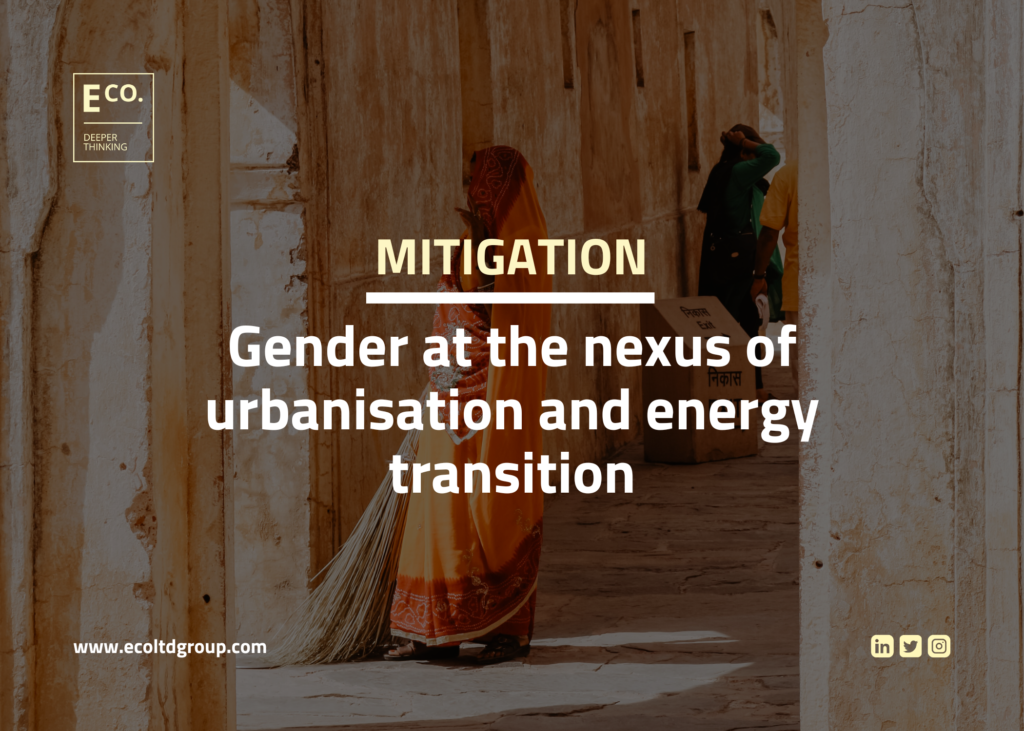Gender at the nexus of urbanisation and energy transition
3 October 2023, Category: All insights, News, Tags: climate change, climate finance, energy, energy transition, equality, gender, urbanisation

The energy transition and urbanisation continue to expand at an unprecedented pace.
The deployment of and investments in renewable energy keep increasing, pushed by technological advances, falling costs for renewables, and political commitments to decarbonize and reduce emissions by 2050. In 2019, renewables accounted for 72% of all new capacity additions worldwide and in 2022 investment in renewable energy reached a record $1.1 trillion, up 30% from the previous year.
Meanwhile, economic development, demographic growth, and improved infrastructure and services are increasing the rate of urbanisation, particularly in developing countries. In 2023, over 56% of the world’s population live in urban areas, a figure that is forecast to grow to 68% by 2050, with most of this increase expected to take place in Africa and Asia.
Cities are particularly relevant for climate, not only for their vulnerability to the impacts of climate change but also because they account for two-thirds of global energy consumption and more than 70% of greenhouse gas emissions.
So how does this impact gender equality?
Why a ‘just’ urban transition?
The clean energy transition and urbanisation are complex processes determined by and impacting on policies, business models, and technological development. Importantly, they are also shaped by and influence social patterns of equality and inclusion. If existing patterns and degrees of inequality and marginalisation are not addressed as the energy transition and urbanisation unfold, there is a risk that these patterns are not only perpetuated but even aggravated.
This calls for a “just urban transition” – namely a process of transitioning to low-carbon cities that provides an equal distribution of benefits, avoids costs that are borne disproportionately by any one group of people, and ensures that no one is left behind, including women, minority groups, and vulnerable people such as persons with disabilities.
Gender equality is essential to a just urban transition. Women are disproportionately affected by the negative impacts of climate change and by urban plans that are still designed around a patriarchal understanding of societal roles. Women are also more likely to be employed in precarious and informal jobs, which are rampant in the sprawling megacities in developing countries, and are more vulnerable to the economic disruptions that accompany transition processes. At the same time, women play a vital role in the transition to more sustainable urban spaces, as managers at the household level, innovators in the clean energy sector, and as actors at the forefront of community-led initiatives to build resilience to climate change.
Gender and the urban energy transition
The transition to more sustainable and equitable cities requires changes in many different areas, including energy, transportation, housing, and urban planning. These changes have a significant impact on women’s lives and livelihoods.
For example, the shift to renewable energy is creating thousands of new jobs, with a higher share of female occupation. Compared to the oil and gas sector, women’s employment in the renewable energy sector is in fact increasing from 22 to 32%, yet 45% of the women occupied in the clean energy sector hold administrative jobs and only 28% perform roles in science, technology, engineering, and mathematics (STEM). So, even with the shift to renewable energies, the energy sector remains largely male-dominated and one of the least appealing and accessible industries for women.
Women are underrepresented also in decision-making and leadership roles in energy-related private and public fields. This further restricts the possibility for women’s views, needs, and expertise to contribute to the design of new energy programs and policies.
Barriers that restrict girls’ and women’s access to and career advancement in the energy sector include :
- Gender stereotypes;
- Lack of access to technical training and education;
- Discrimination and limited flexibility in the workplace;
- Work-life imbalance;
- Few role models;
- Mentoring and networking opportunities for women professionals.
Societal roles and expectations assigning girls and women the main responsibility in caring for children, sick family members, and elderly relatives overload women disproportionately with unpaid care work. As a result, girls and women have fewer possibilities to pursue education, participate in the workforce and benefit from the new opportunities that ensue from the urban and energy transition processes.
In the urban space, more sustainable urban planning can help to create safe and inclusive public spaces, and to ensure that women have equal access to essential services and amenities. Mobility is an important component in this picture, as women are more likely to use public and non-motorised transportation and are thus poised to benefit from investments in public transportation, provided they are affordable and reliable. As urbanisation expands, the availability and access to more affordable and sustainable housing is also critical for women as they are more likely to live in poverty and to be renters, which makes them more vulnerable to displacement and gentrification.
Challenges and opportunities
Despite the challenges identified above, there are multiple opportunities for policymakers and practitioners to promote more gender equality and better social inclusion along the energy and urban transition processes, such as:
- Raising awareness about new social and professional roles and promoting a positive image and an appealing perception of girls in STEM.
- Investing in gender-responsive education and training programs that are specifically designed to prepare women and girls for jobs in the clean energy sector and other growing sectors that are driven by the urban and energy transition processes.
- Promoting fair and inclusive workplace practices, for instance: no tolerance for sexual harassment, equal pay for equal work, gender targets, and flexible arrangements for male and female employees to cater to parenting needs.
- Supporting women-led clean energy businesses and cooperatives, in particular with access to finance, gender-responsive procurement and training opportunities.
- Investing in affordable and sustainable housing.
To achieve a truly equitable and sustainable transition, it is particularly important that women and other marginalised or vulnerable groups are consulted and engaged throughout the design and implementation of these processes, and that gender-disaggregated data are collected. Gender-disaggregated data is key to identify and address the specific needs and challenges of women and girls, and to ensure that they have equal opportunities to benefit from progress.
In so doing, the energy transition and urbanisation can harness an unprecedented opportunity to address existing barriers and gaps between men and women as well as between different social groups, while preventing the creation of new forms of marginalization and discrimination. In turn, this is conducive to the achievement of the Paris Agreement and the 2030 Agenda for Sustainable Development.
What are your thoughts? Let us know in the comments below.

Looking for insight into climate finance? Look no further
Get in touch with our climate finance consultants to discuss a project you’re working on and create successful, fit-for-purpose projects, now and in the future. Email us at: amy@ecoltdgroup.com or find us at the following:
Twitter: @ecoltdnews
LinkedIn: E Co.
Instagram: @ecoltdnews
References
- IRENA, Renewable Account for Almost Three Quarters of New Capacity in 2019, (2020). Available at: https://www.irena.org/News/pressreleases/2020/Apr/Renewables-Account-for-Almost-Three-Quarters-of-New-Capacity-in-2019
- World Economic Forum, Spending on Low-Carbon Energy Technology Is on the Brink of Overtaking Fossil Fuels. These 4 Charts Tell the Full Story, (2023). Available at: https://www.weforum.org/agenda/2023/02/low-carbon-investment-record-2022/
- The World Bank, Urban Development, (2023). Available at: https://www.worldbank.org/en/topic/urbandevelopment/overview
- UNDESA, 68% of the World Population Projected to Live in Urban Areas by 2050, Says UN, (2018). Available at: https://www.un.org/development/desa/en/news/population/2018-revision-of-world-urbanization-prospects.html
- The World Bank, Urban Development, (2023). Available at: https://www.worldbank.org/en/topic/urbandevelopment/overview
- IRENA, Renewable Energy: A Gender Perspective, (2019). Available at: https://www.irena.org/-/media/Files/IRENA/Agency/Publication/2019/Jan/IRENA_Gender_perspective_2019.pdf?rev=bed1c40882e54e4da21002e3e1939e3d
Join the conversation by posting a comment below. You can either use your social account, by clicking on the corresponding icons or simply fill in the form below. All comments are moderated.